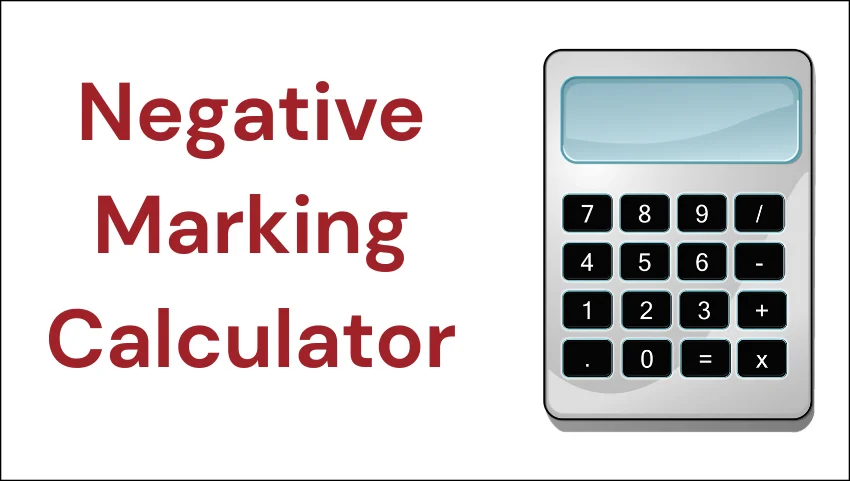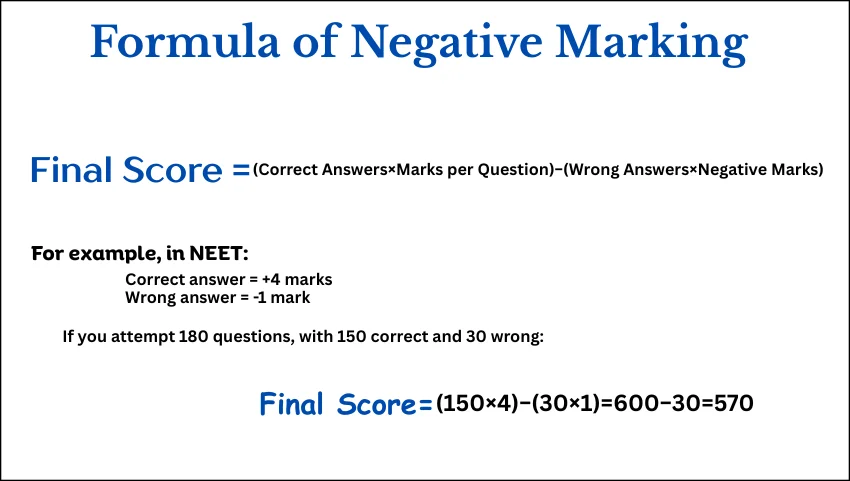Negative Marking Calculator
Advanced exam score calculator with negative marking analysis
No previous calculations
Exams in India, especially entrance exams like NEET, JEE, UPSC Prelims, SSC, and Banking Exams, often use a negative marking system. This system can confuse students and create stress. A Negative Marking Calculator helps students understand how many marks they gain or lose depending on the number of right and wrong answers.
What is Negative Marking?
Negative marking means students lose marks for giving a wrong answer. It is used to prevent blind guessing in competitive exams.

- Right answer = Positive marks added
- Wrong answer = Some marks deducted
- Unanswered = No marks
For example, in many Indian exams:
- 4 marks for a correct answer
- 1 mark deducted for an incorrect answer
So if you attempt 10 questions and get 7 correct and 3 wrong:
- Correct = 7 × 4 = 28
- Wrong = 3 × -1 = -3
- Total = 28 – 3 = 25
This is where a Negative Marking Calculator makes life easy.
Why Do Indian Exams Use Negative Marking?
Indian competitive exams are very tough because millions of students apply and seats are limited. Negative marking ensures that only well-prepared candidates move ahead.
Some key reasons:
- To reduce blind guessing
- To reward accuracy over luck
- To increase fairness in ranking among students
What is a Negative Marking Calculator?
A Negative Marking Calculator is a simple tool where you enter:
- Total questions attempted
- Marks per correct answer
- Marks deducted per wrong answer
- Number of correct and incorrect answers
It instantly calculates your final score.
Think of it like your personal exam score assistant. Instead of doing manual calculations, you save time and avoid errors.
Formula of Negative Marking
The general formula is: Final Score=(Correct Answers×Marks per Question)−(Wrong Answers×Negative Marks)

For example, in NEET:
- Correct answer = +4 marks
- Wrong answer = -1 mark
If you attempt 180 questions, with 150 correct and 30 wrong: Final Score=(150×4)−(30×1)=600−30=570
Step-by-Step Example Using Calculator
Example 1: NEET Exam
- Correct: 120
- Wrong: 30
- Marks per correct: 4
- Negative per wrong: 1
Score=(120×4)−(30×1)=480−30=450
Example 2: SSC CGL
- Correct: 80
- Wrong: 20
- Marks per correct: 2
- Negative per wrong: 0.5
Score=(80×2)−(20×0.5)=160−10=150
Importance of Negative Marking Calculator
- Removes confusion: You don’t need to recalculate again and again.
- Saves time: Useful during practice and mock tests.
- Improves accuracy: No manual mistakes in calculation.
- Motivates students: Helps in analyzing performance easily.
Where Negative Marking is Used in India
Some popular Indian exams with negative marking:
- NEET (Medical Entrance Exam) – 4 marks for correct, -1 for wrong.
- JEE Main – 4 marks for correct, -1 for wrong.
- UPSC Prelims – 2 marks for correct, -0.66 for wrong.
- SSC & Banking Exams – Usually -0.25 for each incorrect answer.
How to Use a Negative Marking Calculator (Step-by-Step)
- Enter the number of correct answers.
- Enter the number of wrong answers.
- Fill in marks per correct answer.
- Enter marks deducted for wrong answers.
- Click on calculate.
Within seconds, you get your final score.
Quick Mental Trick without Calculator
If the exam has +4 for correct and -1 for wrong:
- Just multiply correct by 4.
- Then subtract the number of wrong answers.
Example: 100 correct, 20 wrong = 400 – 20 = 380
A calculator automates this, but this trick is handy in mock tests.
Tips to Reduce Negative Marking
Since negative marking lowers your score, try these tips:
- Don’t guess blindly: if you are completely unsure, leave the question.
- Use the elimination technique: Remove wrong options, then make a logical guess.
- Improve accuracy in practice: The more you practice, the fewer mistakes you make.
- Time management: Don’t rush. Careless mistakes lead to negative marks.
Indian Student Experience: Negative Marking Anxiety
Every Indian student knows the tension of negative marking. Even if you know most answers, one silly mistake can reduce your score. For example:
- In NEET 2023, many students lost their medical college seats because of -1 errors.
- In UPSC Prelims, just 2-3 wrong answers with negative marks can decide your selection.
This is why calculators are widely used by coaching centers in India like Allen, Aakash, and Resonance.
Advanced Use: Analyzing Attempt Strategy
Many smart students use negative marking calculators to check:
- Safe attempt strategy: How many questions to attempt for a good score.
- Risk analysis: If answering 10 extra doubtful questions helps or harms the total.
Example:
- You attempted 80 questions correctly and 20 wrongly in UPSC Prelims.
- Score = (80 × 2) – (20 × 0.66) = 160 – 13.2 = 146.8
If you had left those 20 doubtful, you’d score 160. Sometimes leaving is better!
Why Every Student Should Use It
For Indian students preparing for tough exams, a Negative Marking Calculator is not optional. It helps in:
- Saving hours while checking mock test results.
- Preventing anxiety during self-study.
- Guiding you towards safe exam strategies.
Small Story: Riya from Punjab
Riya, a NEET aspirant from Ludhiana, kept losing marks because of blind guessing. Her teacher suggested using a negative marking calculator after every practice test. Soon, she realized that attempting only the questions she was confident about improved her mock scores. In the final NEET exam, she cleared with a top rank.
Free Practice: Try Yourself
Suppose:
- Correct answers: 105
- Wrong answers: 25
- Marks per correct: 4
- Negative marking: 1
What will be the score?
Calculation: (105×4)−(25×1)=420−25=395
Now use an online calculator and check—the result will be the same!
Common Questions About Negative Marking Calculator
What is a Negative Marking Calculator?
It is an online tool designed to calculate exam scores where marks are deducted for wrong answers, helping to estimate the final score accurately considering negative marking.
How does negative marking work in exams?
Negative marking deducts a specific fraction or value of marks for every incorrect answer, discouraging guessing and encouraging careful answering.
What is the formula used for negative marking calculation?
Total Marks = (Correct Answers × Marks per Correct Answer) − (Incorrect Answers × Marks Deducted per Wrong Answer).
Which exams use negative marking?
Various competitive exams like UPSC, PSC, RRB, UPPSC, BPSC, UPSSSC, JEE, NEET, SSC, and banking exams apply negative marking.
Does the calculator show a detailed analysis?
Yes, some calculators provide performance breakdowns and visual charts to understand the impact of correct and incorrect answers.
Final Thoughts
Negative marking is a challenge, but with the right tools, you can use it to your advantage. A Negative Marking Calculator gives clarity, prevents mistakes, and helps you focus more on accuracy instead of quantity. For students across India preparing for NEET, JEE, UPSC, or SSC, this is a must-use resource.
